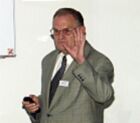Science and business meet at EMPA in Thun
Nanotechnology – an opportunity for innovative businesses
EMPA organized an evening presentation in Thun in conjunction with the regional business development agency InnoBE.

|
"Hey, dad, isn't that just mega?!" – while children enjoy exaggerating everything and blowing things up to gigantic proportions, the "grown-ups" are doing quite the opposite. After the micro-world, researchers are now getting to grips with discovering the nano-world. On 28 October 2002, this atomic world of "dwarfs" ('nanus' is Latin for dwarf) attracted about 50 people to EMPA in Thun for an evening presentation organized with InnoBE. |
||
|
Nanotechnology is not difficult Prof. Hans Joachim Güntherodt from the University of Basel introduced the audience to the world of one billionth of a metre (10-9). He showed the audience, which was composed mostly of lay people, a number of comparisons of magnitude and outlined the development of nanotechnology. This has been possible only since the invention of the scanning tunnel microscope by IBM researchers Rohrer and Binnig, who were honoured for their achievement with the 1986 Nobel prize. Even more important for today's atomic-scale research, however, is the scanning force microscope, which travels over atoms like the needle of a record player, mapping them as it does so. "Nanotechnology is not difficult," maintains Güntherodt; he sees it as a key technological leap forward, like that from the radio valve to the transistor or from the filament lamp to the laser. He sees possible applications in the life sciences, new materials and in the search for alternatives to modern technologies that are approaching their limits. |
||
|
Materials technology on the nano scale For Dr. Lukas Rohr, head of the Thun-based EMPA department, the step from the micrometre to the nanometre also constitutes a quantum leap for real-life materials technology needs. Thanks to nanotechnology, many things that could previously only be investigated in microdimensions can now be explored in nanodimensions. Rohr and his team are working with business partners on projects in areas such as coating technology, nanorobotics and medical technology. "We're also often attempting the impossible", he thinks. "If dreams remain just dreams, it's a waste of time." |
||
|
Nanotubes as a source of electrons Dr. Pierangelo Gröning, formerly of the University of Fribourg and now tasked with setting up a second EMPA department in Thun, reported on his work with nanotubes. Gröning is working with the French company Thomson to develop a new generation of flat screens that use a large number of nanotubes as an electron source. "In nanotechnology we work with the basic building blocks of Nature". However, the intended application demands a very high level of tube uniformity, necessitating enormous precision in manufacture. |
||
|
An opportunity for business – including small and medium-sized companies "Top Nano 21" is an innovation programme set up by the ETH domain to act as a bridge between the universities and industry, but also to give smaller businesses access to nanotechnology. Anton Tauer explained how this can take place. In Switzerland there are already several centres for nanotechnology in the university and university of applied science sectors, as well as in public and private institutions. Interested companies can contact these centres either directly or via "Top Nano 21". The programme provides support by investigating needs and conducting market studies. "Nanotechnology is an interdisciplinary field and must therefore draw interest from people in many different areas". However, the nanometre must also be integrated into education and training: "Before it was micro, but now it's nano", says Tauer. A number of questions from the public and the lively discussion during the subsequent drinks party showed that nanotechnology is indeed a "mega" topic. |
||
